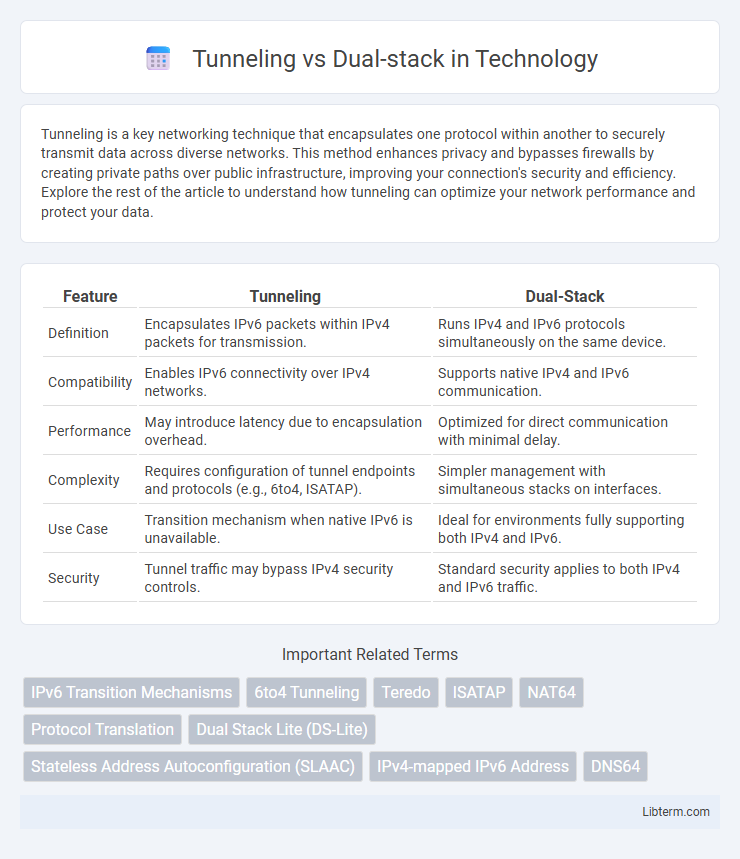Tunneling is a key networking technique that encapsulates one protocol within another to securely transmit data across diverse networks. This method enhances privacy and bypasses firewalls by creating private paths over public infrastructure, improving your connection's security and efficiency. Explore the rest of the article to understand how tunneling can optimize your network performance and protect your data.
Table of Comparison
| Feature | Tunneling | Dual-Stack |
|---|---|---|
| Definition | Encapsulates IPv6 packets within IPv4 packets for transmission. | Runs IPv4 and IPv6 protocols simultaneously on the same device. |
| Compatibility | Enables IPv6 connectivity over IPv4 networks. | Supports native IPv4 and IPv6 communication. |
| Performance | May introduce latency due to encapsulation overhead. | Optimized for direct communication with minimal delay. |
| Complexity | Requires configuration of tunnel endpoints and protocols (e.g., 6to4, ISATAP). | Simpler management with simultaneous stacks on interfaces. |
| Use Case | Transition mechanism when native IPv6 is unavailable. | Ideal for environments fully supporting both IPv4 and IPv6. |
| Security | Tunnel traffic may bypass IPv4 security controls. | Standard security applies to both IPv4 and IPv6 traffic. |
Introduction to IPv6 Transition Mechanisms
IPv6 transition mechanisms such as tunneling and dual-stack play critical roles in enabling interoperability between IPv4 and IPv6 networks during the migration process. Tunneling encapsulates IPv6 packets within IPv4 headers, allowing seamless transmission across IPv4 infrastructure without native IPv6 support, while dual-stack deployment runs both IPv4 and IPv6 protocols simultaneously on devices and network nodes. Understanding tunneling types like 6to4, Teredo, and ISATAP versus dual-stack implementation is essential for effective network planning, ensuring compatibility and minimizing disruption in mixed-protocol environments.
Understanding Tunneling: Definition and Purpose
Tunneling is a network protocol technique that encapsulates IPv6 packets within IPv4 headers to enable IPv6 traffic to traverse IPv4 infrastructure. It addresses compatibility issues in networks that have not fully transitioned to IPv6 by creating a virtual pathway for IPv6 data across IPv4 networks. This method ensures seamless communication between IPv6-only devices through existing IPv4 systems without requiring dual-stack support on every node.
Dual-stack Explained: Operating Dual Protocols
Dual-stack technology enables devices and networks to run both IPv4 and IPv6 protocols simultaneously, ensuring seamless communication across diverse internet infrastructures. By assigning both IPv4 and IPv6 addresses, dual-stack allows for direct routing without encapsulation, improving performance and simplifying network management. This approach supports gradual migration to IPv6 while maintaining compatibility with legacy IPv4 systems, making it a preferred method for modern network deployments.
Key Differences Between Tunneling and Dual-stack
Tunneling encapsulates IPv6 packets within IPv4 packets to enable IPv6 communication over an IPv4 network, while dual-stack involves devices running both IPv4 and IPv6 protocols simultaneously. Tunneling introduces overhead and latency due to encapsulation, whereas dual-stack offers native communication for both IP versions, enhancing compatibility and performance. The key difference lies in implementation complexity and resource usage, with tunneling acting as a transition mechanism and dual-stack representing a long-term coexistence strategy.
Pros and Cons of Tunneling
Tunneling allows IPv6 packets to be encapsulated within IPv4 headers, enabling IPv6 connectivity over existing IPv4 infrastructure without requiring dual-stack support on all devices, which simplifies transitional deployment. Pros include compatibility with legacy IPv4 networks, reduced need for hardware upgrades, and support for IPv6 in environments where native IPv6 routing is unavailable. Cons involve increased latency due to encapsulation overhead, potential MTU size issues causing fragmentation, and complexity in troubleshooting encapsulated traffic.
Advantages and Limitations of Dual-stack
Dual-stack enables simultaneous support for IPv4 and IPv6, allowing seamless communication across both protocols without encapsulation overhead. Advantages include native protocol performance, simplified network management, and gradual IPv6 adoption without disrupting existing IPv4 services. Limitations involve increased complexity in address management, potential security vulnerabilities due to dual protocol exposure, and higher resource consumption on devices handling both IP stacks.
Security Considerations: Tunneling vs Dual-stack
Tunneling methods, such as 6to4 and Teredo, encapsulate IPv6 packets within IPv4, increasing the attack surface by potentially bypassing IPv4 firewall rules and exposing networks to injection or spoofing attacks. Dual-stack configurations run IPv4 and IPv6 simultaneously, enabling direct IPv6 handling but requiring robust security policies for both protocols to mitigate risks like IPv6-specific vulnerabilities and misconfigurations. Organizations must implement comprehensive firewall rules, intrusion detection systems, and monitoring tailored to each approach to ensure secure IPv6 adoption.
Performance Impacts: Speed and Latency Analysis
Tunneling protocols often introduce additional overhead due to encapsulation, resulting in increased latency and reduced throughput compared to dual-stack implementations that natively handle IPv4 and IPv6 traffic. Dual-stack configurations generally provide faster data processing since packets are routed directly without encapsulation, minimizing delays and improving overall network performance. Performance metrics typically show that dual-stack environments achieve lower latency and higher transmission speeds, making them preferable for latency-sensitive applications.
Use Cases: When to Choose Tunneling or Dual-stack
Tunneling is ideal for organizations requiring IPv6 connectivity over existing IPv4 infrastructure without immediate network upgrades, often used in transitional phases or environments where IPv6 deployment is partial. Dual-stack suits enterprises ready to run IPv4 and IPv6 simultaneously, enabling seamless communication across both protocols and supporting gradual migration with minimal disruption. Choosing between tunneling and dual-stack depends on network complexity, resource availability, and the urgency of IPv6 adoption aligned with business needs and device compatibility.
Future Trends in IPv6 Transition Technologies
Tunneling IPv6 over IPv4 networks remains significant for legacy system compatibility, but dual-stack adoption is accelerating due to its native support, enabling simultaneous IPv4 and IPv6 connectivity that reduces latency and complexity. Future trends indicate a shift towards enhanced dual-stack implementations integrating automated address configuration and security enhancements, improving network performance and management. Emerging transition technologies also focus on seamless interoperability and scalability to support growing IoT deployments and increasing IPv6 traffic volumes.
Tunneling Infographic

 libterm.com
libterm.com